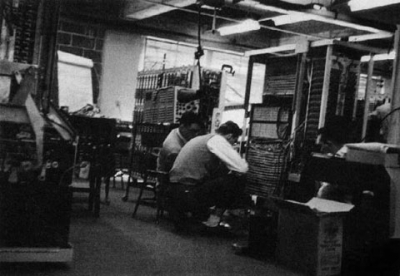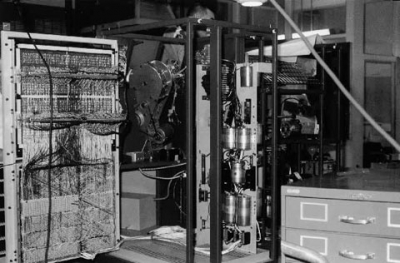Nerd Dawn
Rowayton (Norwalk)
March 13, 2010
I hate that I have to qualify this with “in the US” because some clowns in England developed a computer before our home state heroes, but a) only by a few months and b) their model was lame.
I became interested in this story a few years ago after reading one short sentence in one of the many dusty books of Connecticut “stuff.” “First business computer – Norwalk.”

“Really?!” I thought. That’s incredible! Why isn’t this more widely known? This was important stuff… and I had to learn more and visit the very spot. So I did… In the midst of a day-long fun CTMQ-fest in Norwalk and Weston, I made the drive down to the ritzy Rowayton section of Norwalk and scoped out where it all began: It’s now perhaps the most beautiful combination library/community center in the state.
And it holds a really, really cool history. I’ll learn more, of course, when I visit the Rowayton Historical Society, so for now, just enjoy learning about this fascinating story via their website. I’ve excerpted from two of the several articles about this historic feat from the historical society.
Remington Rand’s First Computer –
A Short History
By W.B. Wenning
James Rand, Chairman and President of Remington Rand, was approached by Loring P. Crosman in 1943 with a plan to build an electronic computer. Remington Rand was known in the business world for its 90-column punch card Tabulating line of equipment.
Crosman’s credentials were rather significant: Twenty years with Monroe Calculating Company, part of that time in charge of Product Development. In anticipation of the technological change taking place that would obsolete mechanical calculating machines, Crosman had taken some electronic courses Columbia University and therefore was not only bringing an idea but a well founded plan which must have impressed Jim Rand because Crosman was hired and went to work at the Brooklyn facility.

Jim Rand apparently recognizing change was on its way began construction of a new laboratory for product development in Norwalk, Connecticut which would eventually be run by General Leslie Groves in 1948. The Brooklyn staff including Crosman began moving into the new facility in 1946.
…
Sometime in 1948 the Crosman group was moved to a carriage house on the grounds of the newly acquired Remington Rand headquarters. The locale was Rowayton, Connecticut (a distinct community within Norwalk) some three miles distant from the Norwalk labs. The facility became known affectionately as the Barn. By the end of 1948 Crosman had demonstrated that his computer designs were fundamentally sound and ready to be productionized for commercialization. The design of the Model 409, basically an extension of the Model 3, was completed in 1948/49 and preproduction components were being fabricated for assembly. The company had reached a level of confidence to begin live demonstrations of the Model 3 in the spring of 1950.
…

A time line created for the period after Remington Rand purchased the James A. Farrell estate in 1944. It indicated that engineering research on the 409 transferred to the Community Center (originally the Farrell estate’s stable and then known as “the barn”) in 1947 after the company moved its research component from Brooklyn, N.Y. Work continued until 1951 when engineers had completed design of the 409, and were transferred back to the main research and development plant at 333 Wilson Ave., South Norwalk where the manufacturing phase was begun. No engineers would work in the barn again until 1961 when they began designing the Univac 1004.
Retired Army Gen. Leslie R. Groves, who had used a two-team competitive approach in the Manhattan Project to develop the atomic bomb during World War II, did the same in developing the 409 after joining Remington Rand following the war. One team led by Loring P. Crosman worked in what is now the Rowayton Library section of the building, while another team directed by Joseph A. Brustman occupied what is now the Community Center portion of the building, the former stable.
“There was a wall between the two teams that went right through the building about where the children’s library is,” said M. James Marin of 21 Woodchuck Lane, a mechanical designer on the 409. “My work station was a former horse stall right about in the middle of the reading room. The place still smelled of horses when I started working here in December of ’49. Marin left Remington Rand in 1955 but returned in 1960 to lead the package design for the Univac 1004, which earned him a U.S. patent.
The 1004 combined reading, processing and printing in one highspeed unit that was so efficient that several thousand units were sold worldwide.
“There was nothing technologically unique about the 1004, but what made it so successful was what it did and what it cost,” said Randmer, at 80 the oldest of the former associates. “The 1004 was all transistorised and had a core memory with an integrated card reader and printer. It was also most reliable for the state of the art at the time.”
…

The biggest thrill for A. Gordon Chamberlain of Cos Cob was delivering the first operational 409 to the IRS building in Baltimore, Md. in 1952.
“We put it in a moving van and when we got across the Hudson River, we had a state police escort all the way down the New Jersey Turnpike that hadn’t yet opened to the public. When we got to Baltimore, we had to put it into the building through an opening in the wall on the second floor. We had more trouble getting it in the building than starting it.”
The 409 was the first electromechanical computer of stand alone, modular design that allowed replacement of parts in modules.
…
“We had 185 people in this place.” Wenning said to disbelieving listeners. “We had six to eight engineers in 10 by 10 cubicles. They were upstairs in both wings, in the basement and all across the main floor. I’ve seen pictures of a drafting room with 60 people in it.”
When Wenning came back to the barn in 1961 after having been at the main plant for a decade, he said: “It felt like home. I saluted the moose and went right to work.” (He was referring to a moose head over the fireplace in the main room of the community center that has been there since the days of the Farrell dominion.) However, he and the rest of his group were unaware that corporate developments would soon move the research group out of the barn once again and the entire operation out of the city.
Sperry Rand would dissolve into Sperry Univac and Sperry Univac would eventually become part of the Unisys Corporation.
“After all I heard today, I think we are now safe in saying that the Rowayton Community Center is the birthplace of the world’s first business computer.” said Rambusch.
And I’m not about to argue with Ramusch.
![]()
CTMQ’s Firsts, Onlies, Oldests, Largests, Longests, Mosts, Smallests, & Bests

 honeybunny says
honeybunny says
March 30, 2010 at 4:49 pmwho was the first blogger?
hb